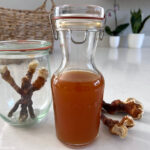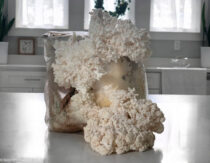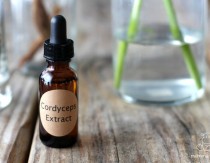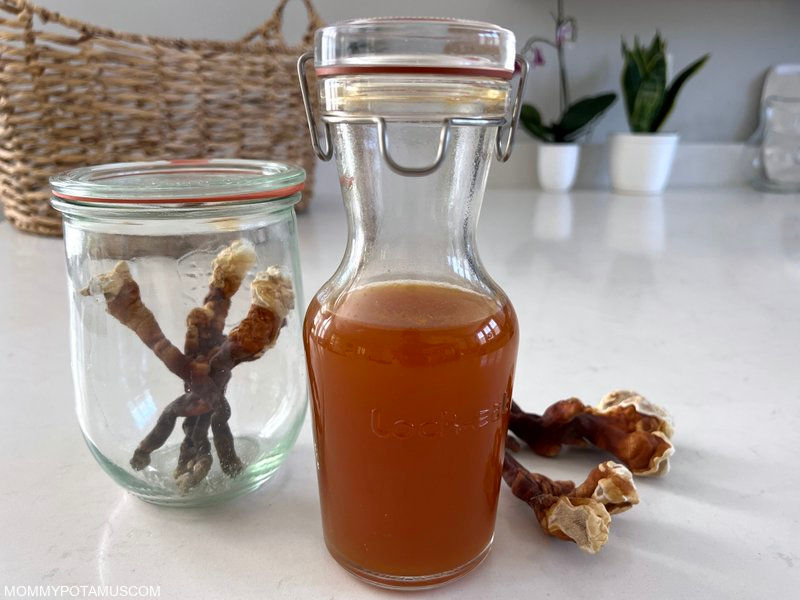
Grab life by the . . . antlers? Okay, that’s not exactly how the saying goes, but when I started growing mushrooms on my kitchen counter I knew the experience would not be complete without a batch of reishi.
Specifically, the gorgeous, antler-shaped red reishi you see in the photo below.
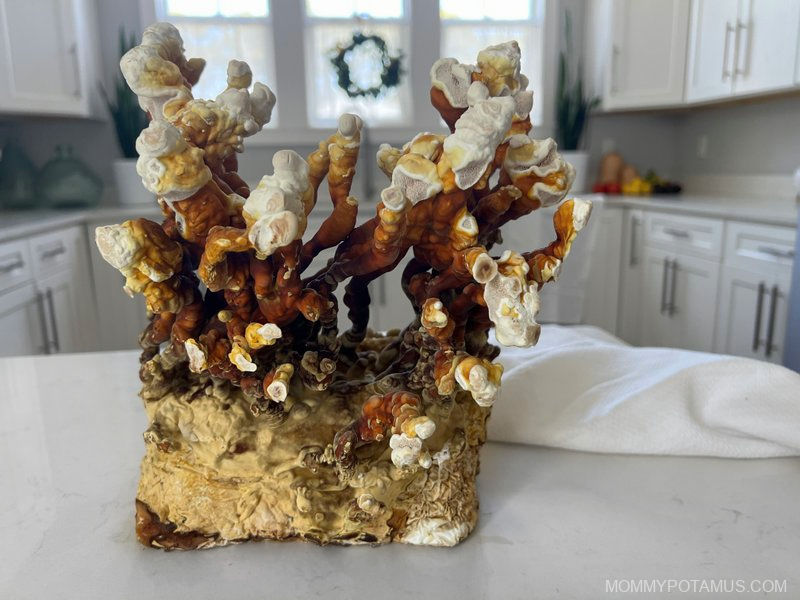
Sure, part of the reason was just that it’s so beautiful and strange, and it didn’t hurt that the kit I used basically requires zero effort. But mostly it’s because reishi contains over 400 bioactive compounds that have profound therapeutic benefits.
In this article I’m going to share how to make a dual-extraction tincture that draws out both water-soluble and alcohol soluble compounds, so you can get the full spectrum of what reishi has to offer.
As always, none of these statements have been evaluated by the FDA, this article is not medical advice, and it is not meant to diagnose or treat any condition. If you have a question about whether reishi (or any other dietary supplement) is right for you, please talk with a qualified healthcare professional. Okay, let’s dive in!
Benefits of Reishi Mushrooms
Sometimes called the “mushroom of immortality” or lingzhi, reishi has been used for thousands of years to promote vitality, support immune function, increase stress resilience, deepen mental clarity and more.
This article takes a deeper dive into its benefits, but here’s a quick overview of some of them:
- Activates “cleanup mode” (cellular autophagy)
- Supports youthful skin when used both internally and externally
- Supports balanced immune function
- Encourages balanced hormone production
- Promotes deep sleep
- Assist with stress relief, mental clarity and energy levels
- Nourishes beneficial bacteria
- Supports healthy liver function
- May provide relief for seasonal sniffles
- May support cardiovascular health
Why Choose A Dual Extraction Tincture?
So you can get the best of both worlds, of course! Some of the benefits I just listed are associated with reishi’s water-soluble compounds, and other are associated with it’s alcohol-soluble compounds.
For example, reishi’s water-soluble polysaccharides are thought to help maintain healthy blood pressure, blood sugar, and cholesterol levels and more. (1) One type in particular – beta glucan – has also been found to support microbiome diversity and balanced immune function. (1) (2)
In Medicinal Mushrooms: A Clinical Guide, Martin Powell writes that polysaccharides are so important for human health that it may be accurate to consider them “essential nutrients for our immune system.”
Unfortunately, water extractions leave behind valuable compounds like triterpenes, which support our ability to utilize oxygen, immune function, liver function and more.
Alcohol is much better at extracting them along with other select compounds, so to get the best of both worlds both water alcohol can be used to extract reishi’s benefits.
The process is called making a dual extraction or double extraction tincture, and you’ll find step-by-step instructions below.
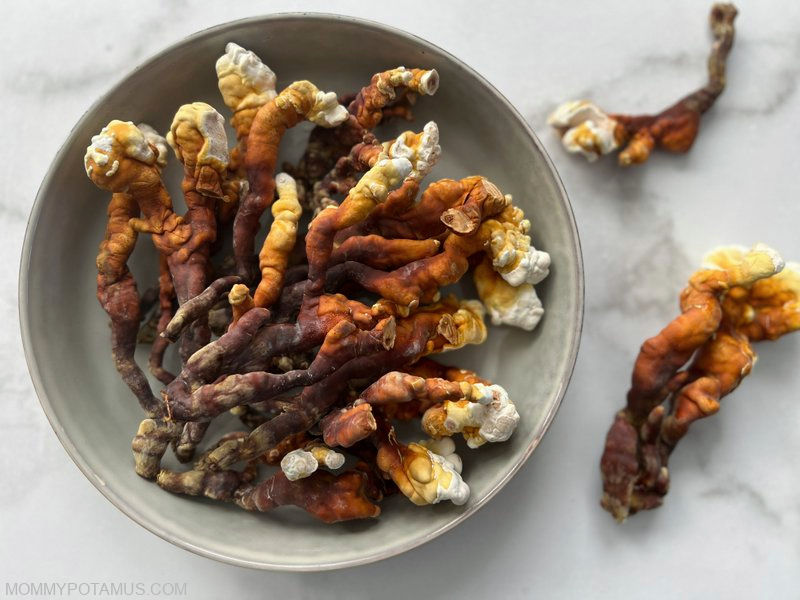
Selecting Your Reishi Mushrooms
In the Bencao Gangmu, which is the classic materia medica of Traditional Chinese Medicine, the five colors of reishi mushrooms (yellow, white, black, purple and red) relate to the five elements (wood, fire, earth, metal and water).
Traditionally, each color was thought to benefit a specific organ, but genetic testing has made things a bit more confusing . . . and a bit clearer, too!
That’s because color is not always a good indicator of species. Red reishi (Ganoderma lucidum), for example, is typically the top choice of herbalists.
However, although “red” is literally in the name it’s not always red. Depending on the time of year and growing conditions it could be yellow or orange, so when choosing your materials it’s important to buy from a reputable source that lists the species used.
- For ridiculously easy to grow fresh red reishi, I like this North Spore kit.
- For dried red reishi, this is a good option
Quick Note: If you’re using fresh reishi mushrooms, make sure to read the selection below on how to prepare them.
What’s the best method?
The first time I decided to make a dual extraction, I consulted all my herbal resources for the best method. What I discovered is that even among expert mycologists and clinical herbalists, there’s quite a bit of variation in the methods used.
Some use chopped mushrooms, and others puree the mushrooms in liquid. Some use the same mushrooms for both alcohol and water extractions, and some split the mushrooms between solvents.
Many herbalists believe that alcohol can damage the valuable polysaccharides found in reishi, so it’s best to extract them before pulling out alcohol-soluble triterpenoids and other beneficial compounds.
The method I use is adapted from Guido Masé’s book, The Wild Medicine Solution. I like it for a couple of reasons:
It’s simple. First I make a tincture, then I make a decoction, and then I mix them together. Easy peasy.
It’s shelf stable. If the right ratio of alcohol to water is used the extract can last for a very long time. Different methods call for different percentages of alcohol by volume (usually 100 proof, 150 proof and 190 proof) as well as different water percentages.
It’s not a good idea to use a different concentration unless you’re up for the challenge of calculating final ABV (alcohol by volume) to make sure your product is shelf stable.
Higher proof alcohols are more effective at drawing out the compounds in reishi, so I opted for a method that is designed to work with the highest proof I can buy (150).
If you have access to 190 proof alcohol, Christopher Hobbs’s Medicinal Mushrooms has an excellent method worth trying. (Yes, there’s supposed to be an “s” before and after the apostrophe in that title.)
He also has a variation that uses 100 proof alcohol if that’s the highest you can find.
Video: Making Dual Extraction Reishi Tincture
In the video below I take you through the process of harvesting fresh reishi, drying it, and extracting it in alcohol and water. If you’re using dried reishi you can skip the first couple of steps.
How To Make Dual Extraction Reishi Tincture
Equipment
- Glass dropper bottle
- Two 16 ounce mason jars
Ingredients
- 2 ounces dried and chopped reishi (Store-bought reishi usually looks different than the reishi in my photos but it can be easily broken into pieces for use in this recipe.
- approximately 12 ounces of 150 proof alcohol
- approximately 3 ounces of glycerin
- purified water
Instructions
- Divide your dried reishi mushrooms into two jars. Set aside one of the jars for step two.
Alcohol Extraction Step
- In your open jar with dried mushrooms inside, pour in high-proof alcohol until the mushrooms are approximately 75% submerged.
- Add glycerin until they’re completely covered.
- Place a piece parchment paper between the lid and the jar before you put it on, then shake the jar so that everything mixes together.
- Let the mixture infuse for 4-6 weeks at room temperature in a dark cabinet. Shake daily, or at least every few days.
- When the tincture is finished infusing, pour it through a mesh strainer lined with cheesecloth. Lift the cheesecloth and give it a good squeeze to get as much liquid out as possible, then measure how much liquid you have.
Water Extraction Step
- Grab your sealed jar of dried mushrooms (the ones you set aside the month before) and place them in a small pot.
- Measure out double the amount of water that your alcohol extract yielded. So, if you got 1 cup or alcohol extract, measure out 2 cups of water.
- Pour the water in the pot with the dried mushrooms. If the water doesn’t fully cover them, add a little more water.
- Bring to a simmer.
- Continue to simmer, uncovered, for at least two hours. By the end of two hours the liquid should reduce by about half. If it looks like too much is evaporating as you simmer, can add more water.
- When the mushrooms have finished simmering, strain them out and measure the amount of liquid you have. It should equal the volume of the strained tincture. If you have too much of the water extraction, add the strained liquid back to your pot and continue to simmer until it matches the volume of the strained tincture.
- Allow the decoction (water extraction) to cool completely.
- Slowly pour the tincture into the water decoction while mixing with a whisk. It’s important to pour the alcohol extraction into the water extraction and not vice versa because it helps preserve the polysaccharide content.
- According to Guido Masé, the final product should be about 35 percent alcohol by volume, which “keeps for years and is convenient to carry and administer.”
- Store in a dark amber dropper bottle or a clear glass jar. If using a clear jar I recommend keeping it in a cabinet when you're not using it to protect the constituents from UV light.
To Use
- Masé recommends using 30 drops 1-2 times per day for allergy support, or up to a full teaspoon 2-3 times per day for more robust immune, recovery or stress/emotional support. He adds that “the more you consume it, the less you’ll need,” so it may be helpful to taper down after an initial period.
Notes
Using Fresh Reishi In Tinctures? Here’s What To Know
It’s best to dry your fresh reishi before use for a few reasons:
- Potency – Water adds weight, so 1 ounce of fresh reishi contains fewer beneficial compounds than 1 ounce of dried. The water content of reishi mushrooms can vary so it’s difficult to determine how to adjust the extraction to maintain similar potency, so I prefer to keep things simple and use dried instead.
- Shelf Life – If you’re extracting reishi in low-proof alcohol, the water content can dilute the extraction to the point that it loses shelf stability. My recipe uses high proof alcohol to counteract this issue, but it’s something to be aware of in general.
Fortunately, it’s super easy. Here’s what to do:
- Chop up the reishi.
- Air dry or place in a dehydrator – Lay the reishi out in a single layer (a baking rack is great if you have it) then place them in a warm area with good airflow for 1-2 weeks. Another option is to pop them in a dehydrator on a low heat setting (about 115F or lower) for about 24 hours. When they’re ready they’ll feel very lightweight and hard as a rock.
Important Note: If you’re using wild reishi or fresh reishi that you purchased, you’ll want to freeze it for three days after it has been dried. This step ensures that any fly larvae that are present are killed.
If you’re using fresh reishi grown with this kit there is no need to freeze. North Spore sterilized the sawdust they use as a growth medium, and since the reishi grows exclusively in a sealed bag there is no risk of bugs making it their home.
Does reishi have any side effects?
According to the Botanical Safety Handbook: 2nd Edition, reishi is a Safety Class 1A herb – the safest rating possible. This category is described as:
Herbs that can be safely consumed when used appropriately.
- History of safe traditional use
- No case reports of significant adverse events with high probability of causality
- No significant adverse events in clinical trials
- No identified concerns for use during pregnancy or breastfeeding
- No innately toxic constituents
- Toxicity associated with excessive use is not a basis for exclusion from this class
- Minor or self-limiting side effects are not bases for exclusion from this class
However, I did find one caution worth adding, which is that “Reishi supplements may cause anticoagulants or antiplatelets to become more effective, which increases the risk of bleeding. Therefore, people whom doctors have scheduled for surgery and individuals with bleeding disorders should not take reishi mushrooms.” (17) (Emphasis mine)
Always check with your doctor before adding herbs to your diet, and listen to your intuition to help you make the best choice for yourself. For a more in-depth discussion of opinions regarding the use of adaptogens during pregnancy/breastfeeding, see this post.
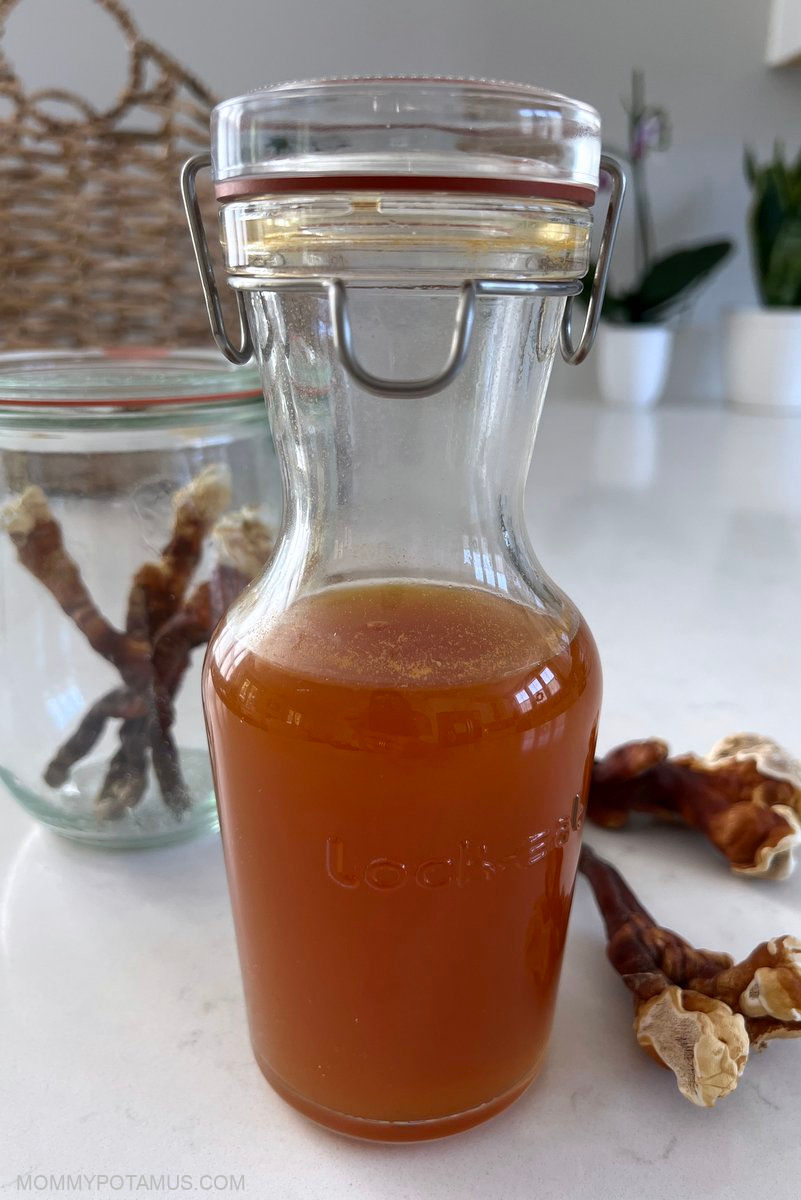
More Mushrooms To Try
Lion’s Mane – Lion’s mane supports the repair & regeneration of neurons, resulting in improved cognitive function. In this article I dive into how it benefits the brain, nervous system, immune system, gut, stress resilience & more.
Chaga – Sometimes called the “King of Mushrooms” or “Black Gold,” chaga has been used for thousands of years to support immune function, relieve stress, and nourish skin from the inside out. Just one cup of chaga tea packs the same number of antioxidants as thirty pounds of carrots.
Cordyceps – Found nestled in the foothills of the Himalaya mountains in Tibet and Bhutan, the cordyceps mushroom has a long history of use in the Chinese herbal tradition. According to Donald Yance, clinical herbalist and author of Adaptogens in Medical Herbalism, “It is considered to be one of the most valuable . . . herbs used traditionally in China, equaling ginseng as a restorative tonic.”
Oyster Mushrooms – Did you know that one of the easiest gourmet mushrooms to grow and prepare also contains therapeutic properties? In this article we’ll cover the top health benefits of oyster mushrooms.
Are you familiar with adaptogens?
Adaptogens are one of the most beneficial types of herbs for stressed, tired moms, but there’s a lot of uncertainty about what’s safe for pregnancy and nursing. I’ve created a free ebook for you – The Beginner’s Guide to Adaptogens – as a gift for signing up for my newsletter.
I researched ten different herbs in the Botanical Safety Handbook and wrote several herb profiles that include benefits, safety info, and recommendations from an expert (ethnobotanist) on how to take them. As a subscriber, you’ll also get updates when I post new recipes and research, exclusive sales and coupons on my favorite products.
Sign up using the form below.
Sources
- Isokauppila, Tero (2017) Healing Mushrooms)
- Ka-Lung Lam and Peter Chi-Keung Cheung (2013) Non-digestible long chain beta-glucans as novel prebiotics

